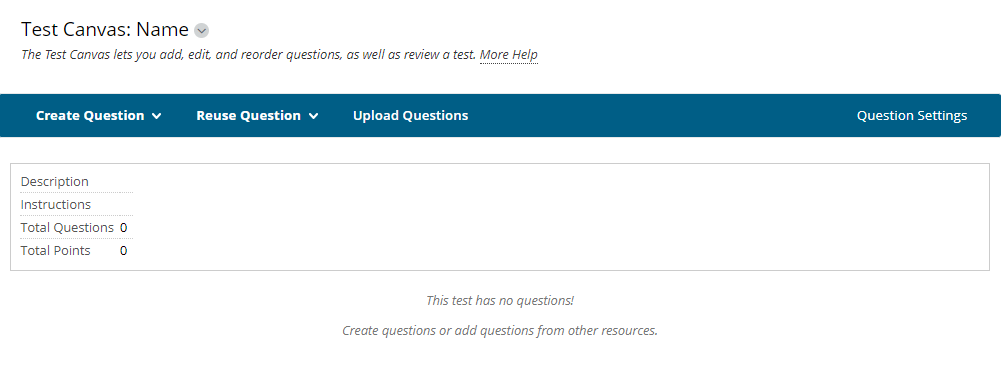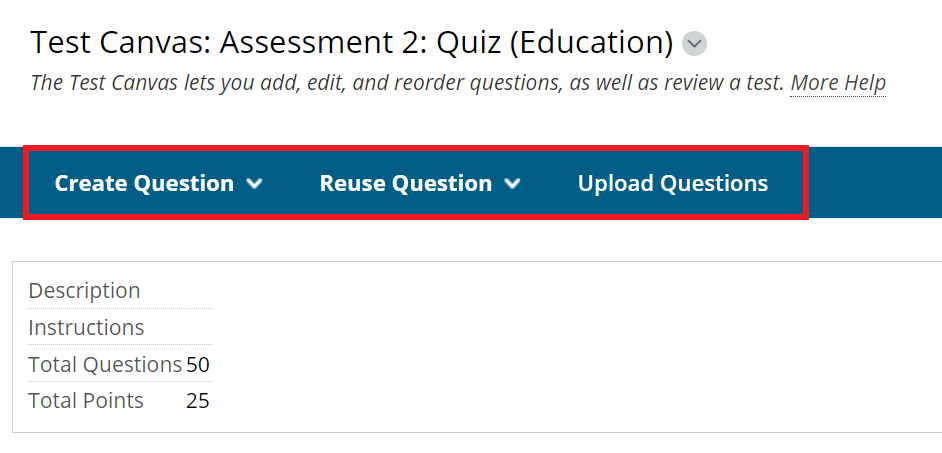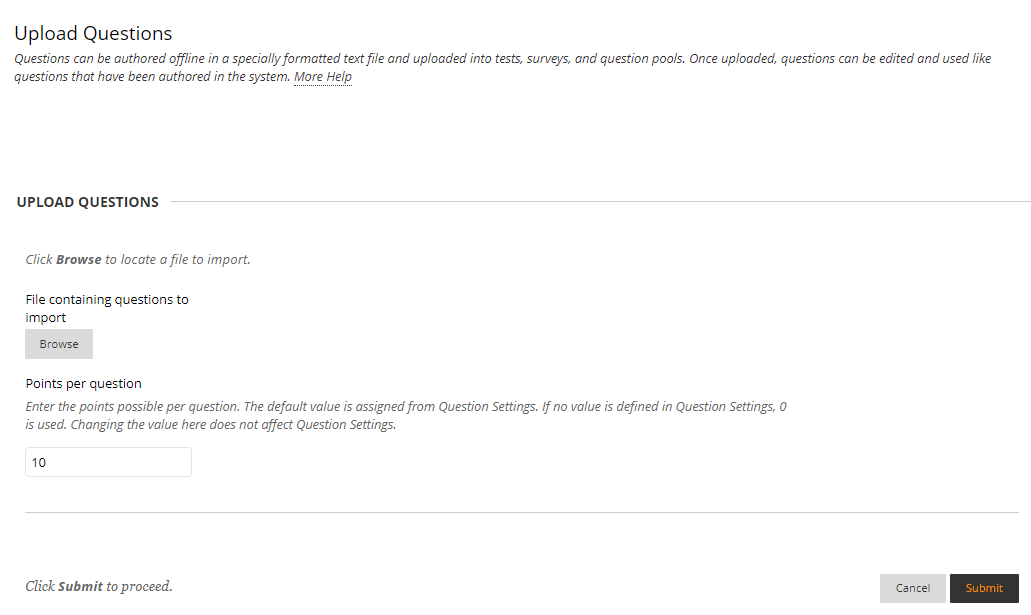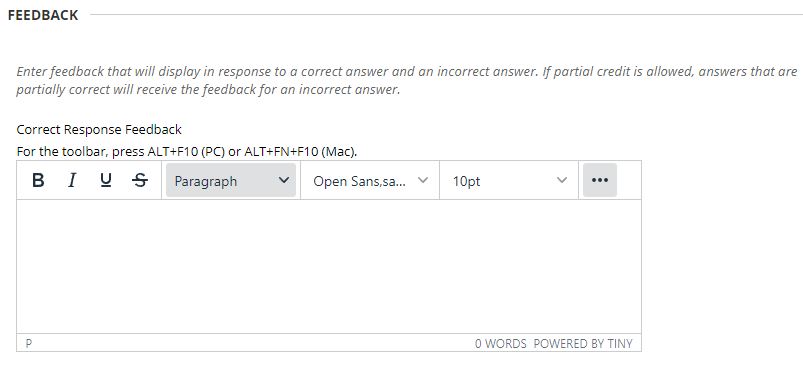Creating questions for a Blackboard test (quiz)
The following article covers creating questions in Blackboard tests, commonly used for low stakes summative assessment. This article covers the following topics:
Before you begin
Please ensure you are familiar with the process of creating a Blackboard test before you begin. You will need to create a Blackboard test first - before questions can be added to it.
It is also a good idea to draft and save all questions and answers in a Word document ahead of time. This ensures that you are able to add questions in one single step, as opposed to writing and editing questions in an online environment - which can introduce errors and is dependent on a stable internet connection to save progress. Refer to the detailed information about the range of question types you can use in a Blackboard test in the table below.
Writing good quiz questions
Determine the Total Points value
Once you have written all the questions you will use, determine the point value for each question that will be in the Blackboard test. Add the question point values together to determine the Total Point value of the test. For a summative assessment, ensure that the Total Points of the test are the same as the weighting of the assessment, i.e. if a quiz is worth 10% of the unit grade, the Total Points must also add up to 10. For example, If the quiz has 20 questions you could make each question worth 0.5 points. Some questions may be worth more points than others.
Total Points must be equal to the assessment weighting
If the assessment weighting (as listed in the unit profile) and Total Points of a Blackboard test are not equivalent, this will inflate/deflate the "Running Total" column in Grade Centre, which impacts the integrity of the Grades Process. Fixing this issue requires overriding the points total in Grade Centre - which can distort and obfuscate assessment results. Make sure you calculate the number of questions and the point values of each question prior to building your test in Blackboard to avoid this issue.
Understanding question types
There are a number of different question types available in a Blackboard test. For many assessments, the Multiple Choice and Multiple Answer question types may be the most familiar and appropriate to use.
The table below provides an overview of the various types of questions available along with a description of each to help you determine which types are will be most useful for your use case.
Question Type | Description | Notes |
Calculated Formula | Students are asked to make a calculation and respond with a numeric answer. The numbers used in each question change between students from a range of values you provide. | Useful for randomising mathematics answers to increase academic integrity |
Calculated Numeric | Students are asked a question that requires a numeric answer. The test will not accept an alphanumeric answer. Answer ranges can be used to accept a range of answer values. | Prevents students from adding text to a numerical answer |
Either/Or | Students must choose from two possible answers: options available are Yes/No, Agree/Disagree, Right /Wrong, and True/False. | Limited use is recommended. |
Essay | Students type their answer in a text box. | Manual marking is required. |
File Response | Students are required to answer the question by uploading a file. | Manual marking is required. |
Fill in the Blank | Students must fill in a single blank in the question with the missing word or words. | Consider if the answer should be an exact match (case sensitive), contains part of the correct answer, or a uses a pattern that you specify. |
Fill in Multiple Blanks | Students must fill in multiple blanks within the question with missing words. Up to 10 blanks per question can be used. | Avoid the use of blanks where multiple terms/words could be confused. |
Hot Spot | Students are presented with an image and required to select the appropriate part of the image that answers the question by pointing and clicking. | Ensure the hotspots are accurate and large enough to detect a correct student response. |
Jumbled Sentence | Students are required to complete sentences by selecting words or phrases from a drop-down list of possible words. The list is the same for all blanks in the sentence and can contain additional words or phrases. | A good alternative to fill in the blanks where terms need to be used in the correct context and spelling/case sensitivity is not a critical part of the question. |
Matching | Students are required to match an item in one column to items in another column. | Use unmatched answer choices and/or more than one match to increase the difficulty and reduce the effectiveness of answer elimination strategies. |
| Multiple Answer | Students can choose more than one correct answer to a question. | More robust than multiple-choice as there are more possible answers. |
Multiple Choice | Students must choose the correct answer from several choices. | The most commonly used question type. You can increase the number of choices to make the question more difficult. |
Opinion Scale/Likert | Students respond to a question/statement by choosing an answer from a comparable scale. | Most useful in surveys, though, can be used in tests if there is a single correct response. |
Ordering | Students provide an answer to a question by placing a series of items in the correct order. | Useful for testing processes where there are linear steps. |
Quiz Bowl | Students are presented with an answer and must provide the question. | Creative use supports students' critical thinking skills. |
Short Answer | Similar to Essay questions, with options to set a smaller-sized text box to indicate the expected answer length. | Manual marking is required. |
True or False | Students must choose either True or False in response to a statement. | Limited use is recommended. |
Avoid binary question types
Binary questions like "True/False" and "Either/Or" are of limited effectiveness because there is a 50% chance of guessing the correct answer. The use of these types of questions can decrease the validity of the quiz so it is recommended to use them sparingly.
Questions that require manual grading
Some question types require manual grading after students have submitted their responses (e.g. short answer). It is generally more efficient to design quizzes using question types that don't require manual grading and to assess freeform written responses using other written assessment tasks such as essays. Using manual grading with low stakes assessment early in the term also prevents students from receiving instantaneous feedback about their progress. Online quizzes are not a substitute for an examination.
Creating a question
Once a Blackboard test has been created, questions can be added to the test. This is done using the Test Canvas (Figure 1).
Create a Blackboard Test
Before creating questions you need to create a Blackboard test, which is outlined in the following article: Setting up a Blackboard test (quiz) for summative assessment
Figure 1: The Blackboard Test canvas
On the test canvas Blackboard test there are 3 main options to choose from:
- Create Question
Create a question from scratch by selecting the preferred question type. - Reuse Question
- Create Question Set: Create a specific question set from a question pool
- Create Random Block: Create a random block of questions from a question pool
- Find Question: Search for questions already included in other quizzes/pools within the unit site
- Upload Questions
Upload existing questions from a file (must be a TXT file with a .txt extension).
These options are illustrated below.
1. Create Question
The first option, Create Question, is used to create a new question for a Blackboard test. The video below demonstrates the creation of a multiple-choice question but the process is similar for all questions types.
2. Reuse Question
The Reuse Question option allows for a test to draw from existing questions or question pools (a group of questions around a particular topic or learning outcome). Question Pools are useful to randomise the questions used in a test which increases the academic integrity of the test. However, these types of tests take considerably longer to set up and ensure they are valid assessments (i.e. that questions drawn from a pool are equivalent).
Reuse a Question from a Pool
For information on how to create a question pool in Blackboard to use for creating a Question Set or Random Block, see this article: Using question pools in Blackboard tests (quizzes) to support Academic Integrity
3. Upload Question
Where large numbers of questions are required it is possible to import text questions from a correctly formatted text file. You will need to ensure that you follow Blackboard's Batch File Guidelines and File Format Rules. Click on More Help on the Upload Questions screen to view detailed information and examples about correctly formatting a text file.
When you chose Upload Question you will be prompted to Browse for the file and then click SUBMIT (see below).
Quiz Generators
If you are developing many questions it may be worth investigating the use of a Blackboard quiz generator which can save you time by creating a correctly formatted document that can be imported as a Blackboard test.
The video below explains how the generator works.
Adding individual question feedback
Correct and incorrect response feedback can be provided for individual questions in a Blackboard Test. Feedback is automatic and affords students an opportunity to learn from their performance on the test. Feedback can include the correct or incorrect student responses, and provide extra detail that reiterates why the chosen answer is correct/incorrect and what remediation strategies could be useful for students to improve in future.
Feedback can be easily added when creating an individual question, under the heading Feedback (see below). If you have already created a question you can Edit the question to add feedback.
Types of feedback
The type of feedback possible will vary depending on the type of question. Some questions allow partial feedback, where a student selects some of the correct answer (e.g. a multiple answer question).
The following video covers the process of adding feedback to individual questions in a Blackboard Test.
Don't forget to add feedback!
Feedback can be added to questions after they have been created. Simply Edit the question to add the desired feedback. However, once the Blackboard test has been deployed to students, no further changes can be made.
Displaying individual question feedback
Individual question feedback does not automatically show students by default. For a practice quiz not included in the students' grades, it might be ideal to show students the feedback "After Submission" in which case students will see the feedback immediately after completing the quiz.
Specify when to show feedback
Make sure to only show feedback for summative assessment after a "Specific Date". This will ensure all students have completed the quiz before the feedback is released. If a student has not completed the quiz before the feedback has been released to others, a new quiz will have to be created for that student - to maintain academic integrity.
- To display the feedback to students, the Blackboard Test "Test Options" must be edited.
- On the edit page scroll down to the section "Show Test Results and Feedback to Students".
- Tick the desired options to show/hide feedback from students.
Watch the video below for more detailed instructions on how to set up "Test Options" to display feedback to students.



